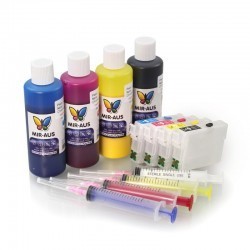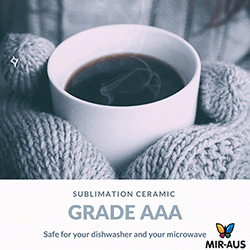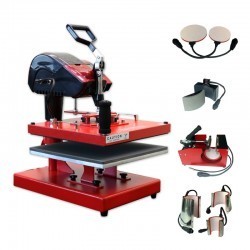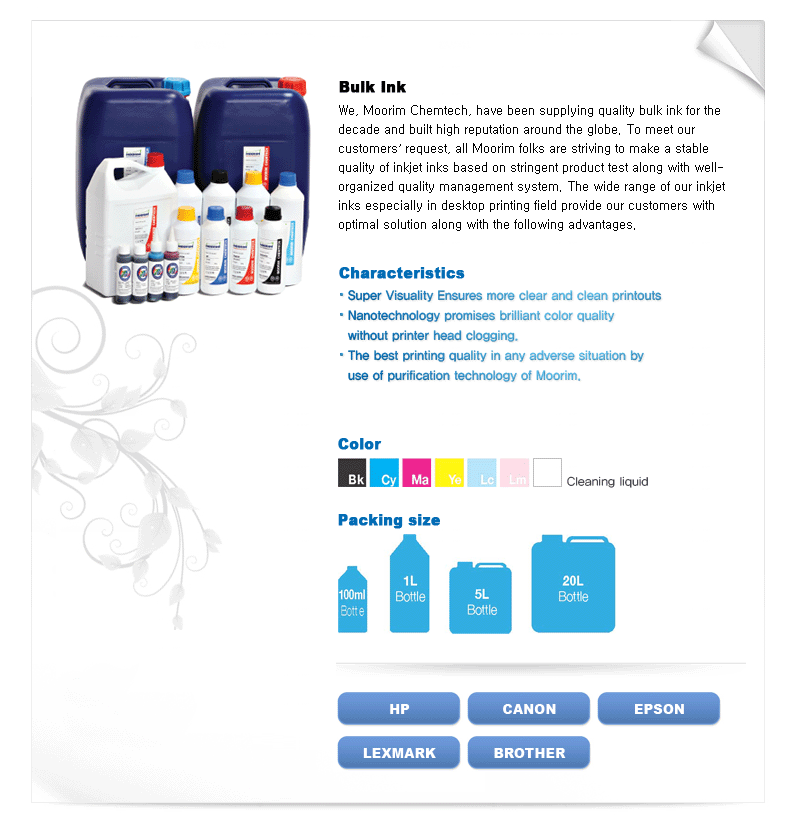
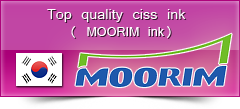
Advanced Technology
Moorim Chemtech, a next-generation leader of ink development based on the newest nanotechnology, is recognized for its Quality in the world market as it expands its realm from narrow to wide format ink. Besides, Moorim Chemtech, which keeps dispersion technology and high-quality ink production technology world-class, will lead the ink industry through persistent R&D, rearing professionals, and the development of its unique ink technology.
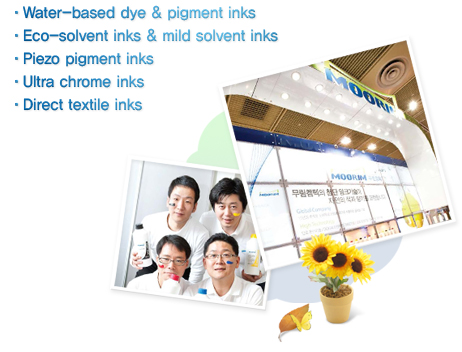
Technical Advantages
- Possession of nano-pigment ink technology through independently developed ink dispersion and refinement technology.
- Possession of highly purified and high-quality dye ink technology through compounded and refinement of inkjet dye technology
- Possession of 50 or more independently developed novel formulations.
Moorim Chemtech is a leader in developing the next generation of ink based on its state-of-the-art technology, which includes outstanding research personnel and modern chemical study equipment.
The pigment produced by the accumulated dispersion technology is recognized for its stable Quality and outstanding output, which is at the highest level globally.

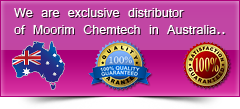

TECH & QUALITY

Moorin' ink for Epson printers, MATERIAL SAFETY DATA SHEET (MSDS)
Moorin' ink for Canon printers, MATERIAL SAFETY DATA SHEET (MSDS)
Moorin' ink for HP printers, MATERIAL SAFETY DATA SHEET (MSDS)
Moorin' ink for Brother printers, MATERIAL SAFETY DATA SHEET (MSDS)
Ink information about HP printers
Ink information about Canon printers
Ink information about Epson printers
Ink information about Brother printers
Ink information about Lexmark printers
1- Dye ink
1-A) Normal Dye Ink
1-B) High Quality Dye Ink (Supplier: Moorim)
2-Pigment Ink
2-A) Normal Pigment Ink
2-B) High-quality pigment ink
(Supplier: Moorim) ***
Piezo nano Chrome ink for Deskjet Printers and Ultra ink for large format printers
(K3 compatible)
*** New Produces
Dye Based Inks
Dyes are water-soluble (dissolve in water) and are known for quickly obtaining saturated, brilliant colours due to their small molecule size, 1.5-4 nanometers.
(1 manometer = 1/1000 of a micrometer, 1 micrometer = 1/1000 of a millimeter). This small particle size refracts or scatters very little light, providing a large colour gamut and allowing the dye to "seep" into most media. This "seeping" enables dye-based inks to be used on media without the inkjet receptor top coat (a coating applied to media by the manufacturer before reaching the customer) necessary for pigmented ink adhesion.
Unfortunately, the same characteristic that provides these advantages is also the source of its poor light fastness and instability in many gas environments. A ph-neutral media is recommended for dye-based inks because they oxidize in an unbalanced pH. Environment, directly affecting dye giclee ink's longevity. Dyes also have poor water and humidity fastness due to their water-soluble nature. When printing on canvas with dye inks, a top coat, like Bulldog Ultra, is recommended for waterproofing.
Pigment Based Inks
The defining characteristic that differentiates dye and pigment-based giclee inks is the complexity and size of their ink particles. The dye "particle" is made up of one molecule. In contrast, the pigment particle comprises numerous molecules bonded by extremely stable chemical bonds, creating a significantly larger particle measured at .05-.20 micrometres. When comparing a particle's surface area and volume, the pigment's relatively tiny surface accounts for its Resistance to resistance agents and chemical attacks. Translated into English, this means pigment inks have better light speed and are less sensitive to humidity and environmental gases. Because water-insoluble pigments are carefully displaced throughout the carrier, most commonly by microencapsulation, which encases each particle in resin, dye-based inks are water soluble. They can become mobile in a high-humidity environment. In contrast, pigment inks are water insoluble and immune to the adverse effects humidity can cause to dye-based prints.
Again, the same attribute that makes pigmented inks so stable is also the characteristic that inhibits them in certain areas. Its larger particle size causes more light to be scattered, resulting in a smaller gamut, making some colours look muted or dull. This is most noticeable when trying to achieve rich reds. However, this can be overcome with careful output and media and profile combinations. Pigment inks are also more susceptible to metameric, which means the shifting of colour under different lighting. As pigment inks evolve, this issue is becoming less and less noticeable. Due to the large particle size of pigmented inks, they cannot simply "seep" into Media and require something to "attach" to an inkjet receptor top coat, which, to the end user, translates to higher media cost. Like Bulldog Ultra, a top coat with pigment inks is recommended for waterproofing when printing on canvas.
What is the difference between standard Dye-based ink and Pigmented ink?
- 1. Water Resistance
- The dye in the dye-based ink dissolves like sugar does in water -- entirely.
- The pigment does not dissolve completely. It is more like a flour and water mixture.
- Because of this, dye-based inks flow better and have been the standard in inkjet printers. However, if drops of water hit the paper, the dye will re-dissolve, and the ink will flow across the paper.
- Pigmented ink particles tend to settle into the tiny fibres of the paper. As the ink dries, the pigment particles get stuck in the fibres. Thus, the pigmented inks are more water-resistant than the dye-based inks. Only about 5 to 10 per cent of the ink will re-flow if the paper is hit by water.
- 2. Fade ReResistancehe reResistanceye-based inks are spread out. You might think of dye-based ink on paper like a beach covered with sand. Because of this, dye-based ink tends to fade quickly since all the molecules are exposed to the chemical and sunlight-caused reactions that fade the ink. You may notice fading of dye-based inks exposed to direct sunlight commonly in 6 to 12 weeks, although when protected from air and sunlight, these inks can last several years. However, new dyes developed by HP and Epson have improved the fade resistance of dye-based inks to be equivalent to the capability of most pigments.
- Pigment particles are similar to large pebbles on a beach. It is much more difficult for sunlight and chemicals to react with all the pigment molecules since most are hidden inside the "pebbles". Pigmented inks will usually last for several months before fading becomes noticeable, and when protected from air and sunlight, these inks can last for many years.
- Special Pigmented inks are those rated as "Archival Quality." Archival-quality pigmented inks use unique pigments to improve their fade performance beyond regular pigmented inks. Fading becomes noticeable when exposed to direct sunlight in 6-12 months, and when protected from air and sunlight, these inks will last for decades.
- For extremely long archival conditions, enclosing a CD with the document or photographs is the best solution. That way, the customer can reprint the material if it is damaged.
- 3. Print Quality
- It is possible to get more "colour" into dyes than pigments. Therefore, dye-based colours tend to be more vibrant than pigment-based colours. And pigmented black inks tend to be slightly lighter than dye-based inks.
- Dye-based black inks are better for text printing, whereas pigmented black inks are often designed more to blend in a graphics application.
- Photography usage depends upon the overall printer design. For example, HP uses pigmented black inks for everyday printing, but their special photo cartridges have an additional dye-based photo black. Epson 6-colour printers often use dye-based inks, whereas their 8-ink systems often use pigmented inks.
- "Special Pigmented" inks have colour vibrancy similar to dye-based inks, but the difference is still noticeable to the professional.
- 4. Price
- "Special Pigmented" inks are significantly more expensive than regular ones because they must blend very well with the other colours.
What is good, and what is the advantage of our inks?
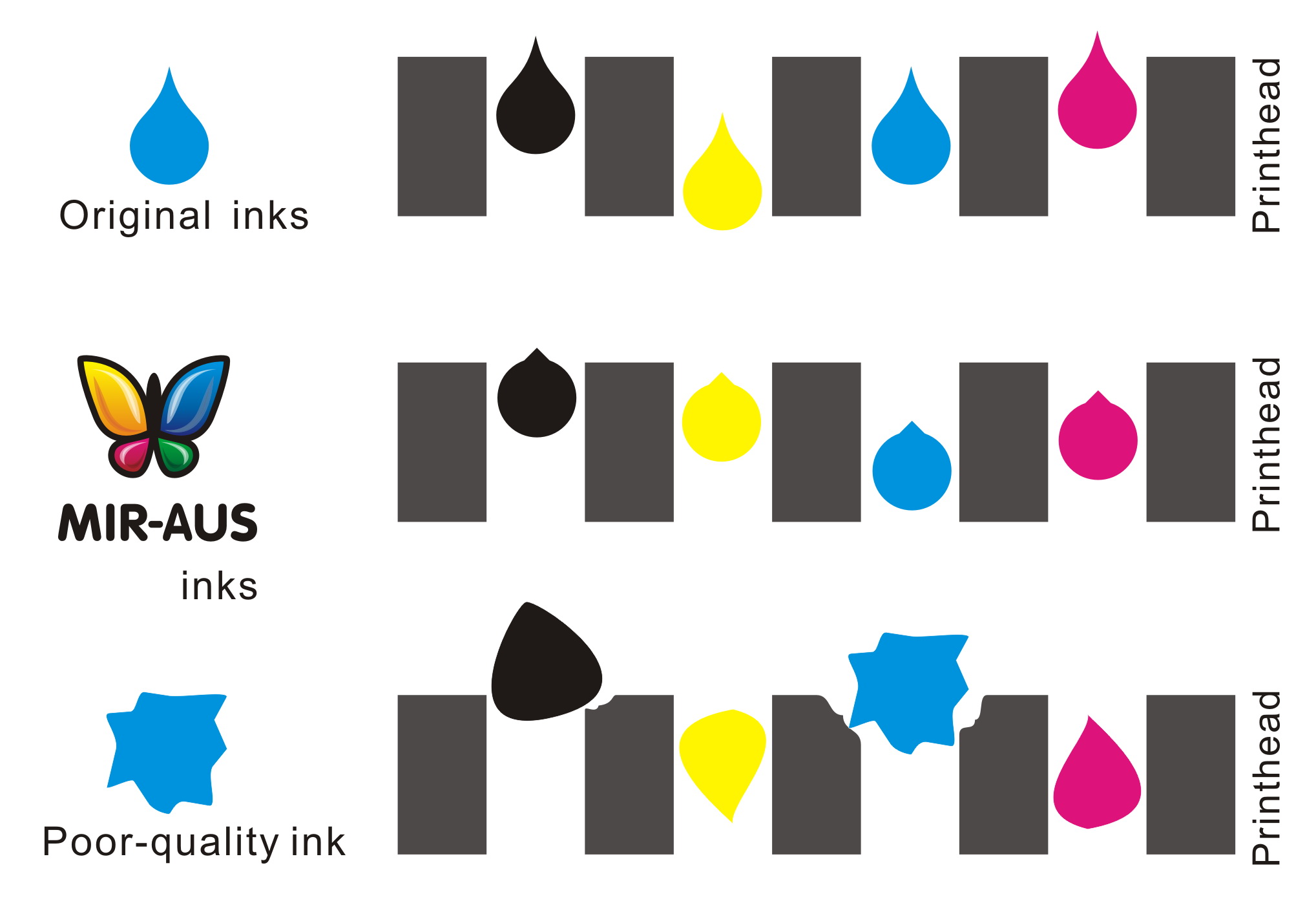
Piezo nano Chrome ink for Deskjet Printers
and
Ultra ink for large format printers ( K3 compatible )
- Characteristics of EUC (NANO-CHROME INK FOR PIEZO HEAD PRINTERS)
1. Brilliant & Customized Colours (C/M/Y/Km/Kp/Lk/LLk/Lc/Lm)
2. High Density of Colours
3. Photo Grade Image
4. Fast Drying
5. High Light-fastness (> 7 grade of pigments)
6. High Durability
7. Environmentally Benign
8. Stable run-ability
9. No nozzle clogging: (after > 5 m2* printing
- Characteristics of WBP (Water-based Pigments) Ink
1. Brilliant & Customized Colours (C/M/YL/YM/K/Lc/Lm)
2. High Density of Colours
3. Photo Grade Image
4. Fast Drying
5. High Light-fastness (>7 grade of pigments)
6. High Durability
7. Environmentally Benign
8. Stable run-ability
9. No nozzle clogging: (after > 30 m2** printing
- Characteristics of HPD (HP5500 Dye) Ink
1. Brilliant Colours (C/M/YL/K/Lc/Lm)
2. High Density of Colours
3. Photo Grade Image
4. Fast Drying
5. High Durability
6. Environmentally Benign
7. Stable run-ability
8. No nozzle clogging (during > 2L printing, three cartridges)
- Characteristics of HUP (HP5500 Pigments) Ink
1. Brilliant & Customized Colours (C/M/YL/K/Lc/Lm)
2. High Density of Colours
3. Photo Grade Image
4. Fast Drying
5. High Light-fastness (>7 grade of pigments)
6. High Durability
8. Stable run-ability
9. No nozzle clogging (during > 2L printing, three cartridges)
- Characteristics of KLS (Konica Low Solvent) Ink
1. Brilliant & Customized Colours (C/MP/MR/YM/YL/K/Lc/Lmp/Lmr)
2. High Colour Density
3. High Permeability
4. Fast Drying
5. High Light-fastness (>7 grade of pigments)
6. High Durability
7. Low Fume
8. Low Smell
9. Very Lower Hazard
10. No Toxicity
11. Ketone free
12. Stable Run-Ability
13. No Nozzle Clogging (after >30 m2* printing
- EES-SLINK (ECO SOLVENT INK FOR PIEZO HEAD PRINTERS)
1. Brilliant & Customized Colours (C/MP/MR/YM/YL/K/Lc/Lmp/Lmr)
2. High Permeability
3. Fast Drying
4. High Light-fastness (> 7 grade of pigments)
5. High Durability
6. Low Fume
7. Low Smell
8. Very Lower Hazard
9. No Toxicity
10. Ketone free
11. Stable Run-Ability
12. No Nozzle Clogging (after >30 m2** printing

